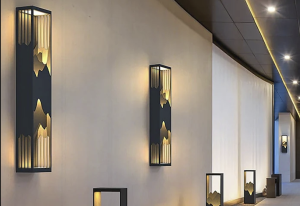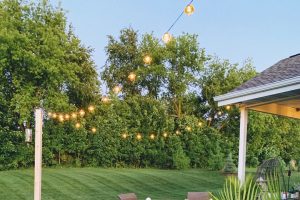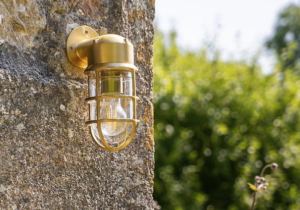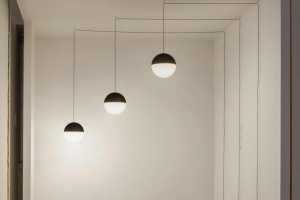Enhance Your Outdoor Space with Garden Lamps

Garden lamps are essential components of outdoor spaces, serving both functional and decorative purposes. These lighting fixtures are specifically designed to illuminate and accentuate gardens, walkways, and outdoor living areas. They are available in diverse styles, sizes, and designs, allowing for versatile application in various outdoor settings.
Garden lamps enhance the aesthetic appeal of landscapes while also providing safety and security by illuminating dark areas and potentially deterring intruders. The incorporation of garden lamps can significantly transform outdoor spaces, regardless of their size, creating an inviting and enchanting atmosphere. Garden lamps are manufactured using a variety of materials, including stainless steel, aluminum, copper, and plastic.
They can be powered by different sources, such as electricity, solar energy, or traditional fuels like oil or gas. Technological advancements have led to the widespread use of LED bulbs in garden lamps, offering energy efficiency and longevity. These lamps can be installed in various ways, including freestanding units, wall or fence-mounted fixtures, or integrated elements within landscape designs.
The wide array of options available enables homeowners to select garden lamps that harmonize with the overall style and theme of their outdoor spaces.
Types of Garden Lamps
Traditional Post Lamps
One popular option is the traditional post lamp, which is typically mounted on a tall post and provides ambient lighting for pathways and garden beds. These lamps come in various designs, from classic lantern-style to modern and sleek.
Wall-Mounted Lamps
Another common type is the wall-mounted lamp, which is ideal for illuminating outdoor seating areas, entryways, and patios. These lamps can be installed on exterior walls or fences, adding a touch of elegance and functionality to the space.
Eco-Friendly Options
For those looking for an eco-friendly option, solar-powered garden lamps are a great choice. These lamps harness the power of the sun during the day and automatically turn on at night, providing soft and ambient lighting without the need for electricity. Solar garden lamps come in a variety of styles, including stake lights, string lights, and decorative lanterns.
Low-Voltage Electric Lamps
Additionally, there are also low-voltage electric garden lamps that are easy to install and cost-effective to operate. These lamps are perfect for highlighting specific features in the garden, such as trees, sculptures, or water features.
Choosing the Right Garden Lamps for Your Space
When choosing garden lamps for your outdoor space, it’s important to consider the specific needs and requirements of the area. Start by assessing the size and layout of your garden or outdoor space. For larger areas, consider installing multiple lamps to ensure adequate lighting coverage.
Next, think about the purpose of the lighting. Are you looking to create a warm and inviting ambiance for outdoor gatherings, or do you need functional lighting for pathways and walkways? Understanding the intended use of the garden lamps will help you determine the type and style that best suits your needs.
Consider the overall design and theme of your outdoor space when selecting garden lamps. For traditional or rustic gardens, opt for classic lantern-style lamps with a timeless appeal. If you have a modern or contemporary outdoor space, sleek and minimalist designs may be more suitable.
Additionally, take into account the material and finish of the lamps to ensure they complement the existing elements in your garden, such as furniture, planters, and hardscape features. It’s also important to choose lamps that are weather-resistant and durable to withstand outdoor elements such as rain, wind, and sun exposure.
Placement and Installation of Garden Lamps
Proper placement and installation of garden lamps are crucial for achieving optimal lighting effects and functionality. When positioning lamps along pathways and walkways, place them at regular intervals to ensure even illumination and safe navigation. For larger gardens, consider installing taller post lamps at key points to provide overall ambient lighting, while using smaller accent lights to highlight specific features such as plants or architectural elements.
Wall-mounted lamps should be strategically placed to provide adequate lighting for seating areas and entry points while adding visual interest to the exterior walls. Before installing garden lamps, it’s important to consider the power source and wiring requirements. Solar-powered lamps offer flexibility in placement since they do not require electrical wiring or outlets.
However, they do require direct sunlight to charge effectively. Electric-powered lamps may require professional installation to ensure proper wiring and connection to a power source. It’s essential to follow manufacturer guidelines and local building codes when installing garden lamps to ensure safety and compliance.
Additionally, consider using timers or motion sensors to automate the operation of the lamps for added convenience and energy efficiency.
Benefits of Using Garden Lamps
The use of garden lamps offers a multitude of benefits for outdoor spaces, making them a valuable addition to any landscape design. One of the primary benefits is enhanced safety and security. Properly illuminated pathways and outdoor areas reduce the risk of accidents and provide a sense of security by deterring potential intruders.
Garden lamps also extend the functionality of outdoor spaces by allowing for evening gatherings, dining, and relaxation long after sunset. The soft glow of garden lamps creates a warm and inviting ambiance that enhances the overall enjoyment of the outdoor environment. In addition to practical benefits, garden lamps also contribute to the aesthetic appeal of outdoor spaces.
They can highlight architectural features, landscaping elements, and focal points within the garden, adding depth and visual interest to the landscape. Whether used as standalone fixtures or integrated into the overall design scheme, garden lamps have the ability to transform an ordinary outdoor space into a captivating and enchanting environment. Furthermore, with advancements in energy-efficient technology such as LED bulbs and solar power, garden lamps offer an environmentally friendly lighting solution that reduces energy consumption and minimizes environmental impact.
Maintenance and Care for Garden Lamps
Cleaning and Inspection
Start by cleaning the lamps regularly to remove dirt, dust, and debris that can accumulate on the surfaces. Use a soft cloth or sponge with mild soap and water to gently wipe down the fixtures, taking care not to damage any electrical components. For solar-powered lamps, it’s important to clean the solar panels periodically to maintain efficient charging capabilities. Inspect the bulbs and wiring for any signs of damage or wear, replacing any faulty components as needed to prevent electrical issues or malfunctions.
Stability and Integrity
Ensure that freestanding lamps are securely anchored in the ground or on a stable base to prevent tipping or damage from strong winds or inclement weather. For electric-powered lamps, inspect the wiring connections and junction boxes for any signs of corrosion or damage that may affect performance.
Protection and Preservation
Consider applying a protective sealant or coating to metal fixtures to prevent rust or corrosion caused by exposure to moisture and humidity. By staying proactive with maintenance and care, you can prolong the lifespan of your garden lamps and keep them looking their best year-round.
Creative Ways to Use Garden Lamps in Your Outdoor Space
In addition to traditional placement along pathways and in garden beds, there are many creative ways to use garden lamps in your outdoor space. Consider hanging string lights or lanterns from trees or pergolas to create a magical canopy effect for evening gatherings or special events. Use stake lights to outline flower beds or define borders within the garden for added visual appeal.
Incorporate underwater lights in ponds or water features to create a mesmerizing reflection effect at night. For a dramatic effect, use uplighting to illuminate trees or architectural elements from below, casting striking shadows and highlighting unique textures. Additionally, consider using colored LED bulbs to create a festive atmosphere for outdoor parties or holidays.
Experiment with different heights and angles when placing garden lamps to create depth and dimension within the landscape. By thinking outside the box and exploring creative lighting techniques, you can elevate the visual impact of your outdoor space while adding a touch of enchantment and charm. In conclusion, garden lamps are an essential element in creating a captivating and functional outdoor environment.
With a wide variety of types and styles available, it’s easy to find the perfect fit for any outdoor space. By carefully considering placement, installation, maintenance, and creative applications, you can maximize the benefits of garden lamps while enhancing the beauty and ambiance of your outdoor living area. Whether used for safety, security, aesthetics, or entertainment purposes, garden lamps play a vital role in transforming ordinary outdoor spaces into extraordinary retreats that can be enjoyed day or night.





